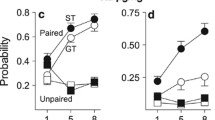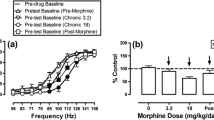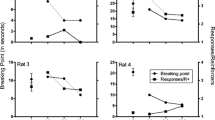Abstract
Rats with bilaterally implanted lateral hypothalamic electrodes were tested daily for self-stimulation to each side of the brain, and rotation (circling behavior) was recorded concomitantly. All rats rotated in a preferred direction regardless of the side of the brain stimulated and all rats had asymmetries in self-stimulation sensitivity related to the direction of rotation. Morphine increased rotation and lowered self-stimulation thresholds at low doses (e.g., 2.5 mg/kg) and decreased rotation and raised self-stimulation thresholds at high doses (e.g., 20.0 mg/kg). The changes in self-stimulation thresholds preferentially occurred on opposite sides of the brain, i.e., the low-dose decrease in thresholds was greater in the normally less sensitive side of the brain whereas the high-dose increase in thresholds was greater in the normally more sensitive side of the brain. Naloxone produced no changes in rates of rotation but did elicit small changes in self-stimulation that varied with the side of the brain, i.e., dose-related decreases in thresholds occurred in the normally more sensitive side of the brain whereas dose-related increases in thresholds occurred in the normally less sensitive side of the brain. Subsequently rats were tested in a choice procedure providing concurrent access to rewarding stimulation of either side of the brain; currents were titrated such that, under baseline conditions, rats continually alternated between self-stimulating one side of the brain or the other. Morphine induced a preference for the less sensitive side of the brain that was comparable in magnitude at all doses and independent of its biphasic effects on rates of responding. Naloxone induced a dose-related preference for the more sensitive side of the brain while not altering rates of responding. Naloxone (1.0 mg/kg) also completely antagonized the effects of all doses of morphine. The results are discussed in terms of lateralized actions mediating the discriminable effects of reinforcing drugs.
Similar content being viewed by others
References
Arbuthnott GW, Crow TJ (1971) Relation of contraversive turning to unilateral release of dopamine from the nigrostriatal pathways in rats. Exp Neurol 3:484–491
Belluzzi JD, Stein L (1977) Enkephalin may mediate euphoria and drivereduction reward. Nature 266:556–558
Blumberg H, Dayton HB, George M, Rappaport DN (1961) N-Allynooxymorphone: A potent narcotic antagonist. Fed Proc 20:311
Denenberg VH (1981) Hemispheric laterality in animals and the effects of early experience. Behav Brain Sci 4:1–49
Esposito RU, Kornetsky C (1978) Opioids and rewarding brain stimulation. Neurosci Biobehav Rev 2:115–122
Gimino F, Farrell R, Tempel A, Steiner SS, Ellman SJ (1979) The site specific effects of naloxone on intracranial self-stimulation rates in the rat. Neurosci Abstr. 5:648
Glick SD, Cox RD (1978) Nocturnal rotation in normal animals: Correlation with amphetamine-induced rotation and effects of nigrostriatal lesions. Brain Res 150:149–161
Glick SD, Jerussi TP, Zimmerberg B (1977) Behavioral and neuropharmacological correlates of nigrostriatal asymmetry in rats. In: Harnad S (ed) Lateralization in the nervous system. Academic, New York, pp 213–249
Glick SD, Ross DA (1981) Lateralization of function in the rat brain: Basic mechanisms may be operative in humans. Trends Neurosci 4:196–199
Glick SD, Weaver LM, Maibach RC (1980) Lateralization of reward in rats: Differences in reinforcing thresholds. Science 207:1093–1095
Glick SD, Weaver LM, Maibach RC (1981) Amphetamine enhancement of reward asymmetry. Psychopharmacology 73:323–327
Greenstein S, Glick SD (1975) Improved automated apparatus for recording rotation (circling behavior) in rats or mice. Pharmacol Biochem Behav 3:507–510
Rerussi TP, Glick SD (1976) Drug-induced rotation in rats without lesions: Behavioral and neurochemical indices of a normal asymmetry in nigrostriatal function. Psychopharmacology 47:249–260
Kuhn DM, Greenberg I, Appel JB (1976) Stimulus properties of the narcotic antagonist pentazocin: Similarity to morphine and antagonism by naloxone. J Pharmacol Exp Ther 196:121–127
Overton O (1971) Discriminative control of behavior by drug states. In: Thompson T, Pickens R (eds) Stimulus properties of drugs. Appleton Century Crofts, New York, pp 87–110
Pellegrino LJ, Cushman AS (1967) A stereotaxic atlas of the rat brain. Appleton Century Crofts, New York
Perry A, Esposito RU, Kornetsky C (1981) Effects of chronic naloxone treatment on brain-stimulation reward. Pharmacol Biochem Behav 14:247–249
Stapleton JM, Merriman VJ, Coogle CL, Gelbard SD, Reid LD (1979) Naloxone reduces pressing for intnracranial stimulation of sites in the periaqueductal gray area, accumbens nucleus, substantia nigra and lateral hypothalamus. Physiol Psychol 7:427–436
Van der Kooy D, LePaine FG, Phillips AG (1977) Apparent independence of opiate reinforcement and electrical self-stimulation systems in rat brain. Life Sci 20:981–986
Zimmerberg B, Glick SD, Jerussi TP (1974) Neurochemical correlate of a spatial preference in rats. Science 185:623–625
Author information
Authors and Affiliations
Rights and permissions
About this article
Cite this article
Glick, S.D., Weaver, L.M. & Meibach, R.C. Asymmetrical effects of morphine and naloxone on reward mechanisms. Psychopharmacology 78, 219–224 (1982). https://doi.org/10.1007/BF00428154
Received:
Accepted:
Issue Date:
DOI: https://doi.org/10.1007/BF00428154




